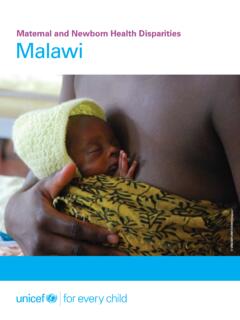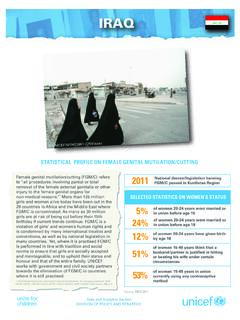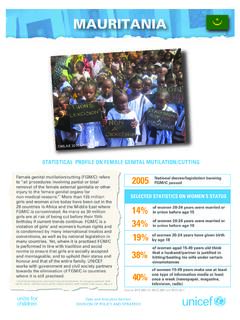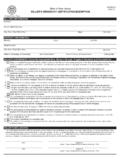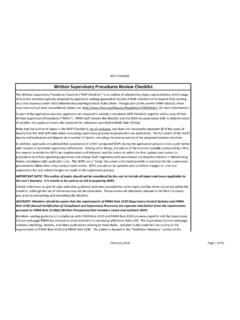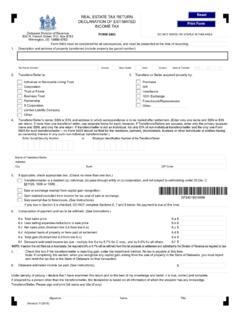Transcription of BANGLADESH EDUCATION FACT SHEETS 2020 - UNICEF
1 BANGLADESH EDUCATIONFACT SHEETS 2020 ANALYSIS FOR LEARNING AND EQUITYUSING BANGLADESH MICS 2019 BANGLADESH EDUCATION fact SHEETS 2020 | Analysis for learning and equity using BANGLADESH MICS 20191 ANALYSIS FOR LEARNING AND EQUITY USING BANGLADESH MICS 2019 BANGLADESH EDUCATION fact SHEETS 2020 The 2020 BANGLADESH EDUCATION fact sheet jointly produced by BANGLADESH Bureau of Statistics (BBS), UNICEF New York and UNICEF Bureau of Statistics (BBS)Mr. Mashud Alam, Director, Demography and Health Wing, Mr. Abdur Rashid Howlader, Programmer, and Mr. Mohammad Fakhrul Hassan, St atistical Of ficer, BANGLADESH Bureau of Educational Information and St atistics (B ANBEIS). Suguru Mizunoya, Raphael Angieri, Diogo Amaro and Sakshi Mishra of the EDUCATION team in the Data and Analytics section , Division of Data, Analytics, Planning and Monitoring, with support from many helping hands.
2 Iv an Coursac from the Regional Office for South Asia. UNICEF BangladeshMr. Mekonnen Woldegorgis, Chief, SPEAR section ; Mr. Deepak Kumar Dey , St atistics and Monitoring Specialist; Mr. Iqbal Hossain, EDUCATION Specialist; Mr. Mashiur Rahman Khan, St atistics and Monitoring Of ficer; Mr. Mohammad Nahid Mia, Research Officer (Consultant).We would lik e to express our deepest gratitude to the government ministers and their representatives from BANGLADESH who participated in the MICS-EAGLE pilot projects in 20 19, and without whose support this initiative could not have work was supported by the Global Partnership for EDUCATION Knowledge and Innovation Ex change, a joint endeavour with the International Development Research Centre, purpose of publishing this factsheet produced by the UNICEF BANGLADESH Of fice is to fulfil a corporate commitment to transparency through the publication of all completed research.
3 The factsheet is designed to stimulate a free exchange of ideas among those interested in the topic and to assure those supporting the work of UNICEF that it rigorously examines its strategies, results, and overall contents of the factsheet do not necessarily reflect the policies or views of text has not been edited to official publication standards and UNICEF accepts no responsibility f or designations in this publication do not imply an opinion on the legal st at us of an y country or territory, or of its authorities, or the delimitation of copyright for this document is held by the United Nations Children s Fund. Permission is required to reprint/reproduce/photocopy or in an y other way to cite or quote from this manual in written form. UNICEF has a formal permission policy that requires a written request to be submitted.
4 For non-commercial uses, the permission will normally be granted free of cit ation: UNICEF BANGLADESH . 2020. BANGLADESH EDUCATION fact SHEETS 2020: Analysis for learning and equity using BANGLADESH MICS Cover Photo: UNICEF /Mawa/UNI248811 Design: Azad/DrikACKNOWLEDGEMENTS3 TABLE OF CONTENTS Introduction4 Topic 1 Early Learning 6 Topic 2 Skills and Learning Outcomes 11 Topic 3 Completion17 Topic 4 Out-of-School Children23 Topic 5 Repetition and Dropouts30 Topic 6 Inclusive Education35 Topic 7 Child Protection40 TABLE OF CONTENTSBANGLADESH EDUCATION fact SHEETS 2020 | Analysis for learning and equity using BANGLADESH MICS 20194 What is MICS? UNICEF launched Multiple Indicator Cluster Surveys (MICS) in 1995 to monitor the status of children around the world. Over the past twenty-five years, this household survey has become the largest source of statistically sound and internationally comparable data on women and children worldwide, and more than 330 MICS surveys have been carried out in more than 115 surveys are conducted by trained fieldworkers who perform face-to-face interviews with household members on a variety of topics.
5 MICS was a major data source for the Millennium Development Goals indicators and continues to inform more than 150 Sustainable Development Goals (SDG) indicators in support of the 2030 Sustainable Development has been updated several times with new and improved questions. The current version, MICS6, was deployed in 2017 and is being implemented in 58 countries. MICS6 includes new modules that track SDG4 indicators related to EDUCATION such as learning ( ), Early Childhood Development and EDUCATION ( and ), information and communication technology skills (ICT ), and child functioning (child disability ), as well as parental involvement in is MICS-EAGLE? UNICEF launched the MICS-EAGLE ( EDUCATION Analysis for Global Learning and Equity) Initiative in 2018 with the objective of improving learning outcomes and equity issues in EDUCATION by addressing two critical EDUCATION data problems gaps in key EDUCATION indicators, as well as lack of effective data utilization by governments and EDUCATION stakeholders.
6 MICS-EAGLE is designed to: Support EDUCATION sector situation analysis and sector plan development by building national capacity, and leveraging the vast wealth of EDUCATION data collected by MICS-2019; and Build on the global data foundation provided by MICS-2019 to yield insights at the national, regional, and global level about ways to ensure each child can reach his or her full potential by reducing barriers to is profiling?One of the characteristics of this fact sheet is profiling. Profiling illustrates the demographic and socioeconomic characteristics of children in a certain category. Profiling answers questions such as what percentage of a key population group is male and what percentage is female? or what percentage of a key population group lives in rural areas and what percentage lives in urban areas?
7 Because profiles examine all children within a key population group, the sum of various characteristics always adds up to 100 per example, a profile of children not completing primary EDUCATION will show what the main characteristics of children in the key population group for this indicator are. As primary completion rates investigate children aged 4 6 years older than the entry age for children for the last grade of primary school, the target population will be children aged 13 15 years who have not completed primary EDUCATION . In BANGLADESH , 69 per cent of children of the key population group not completing primary EDUCATION are male, therefore 31 per cent have to be female. In turn, 20 per cent of children of the target population not completing primary EDUCATION live in urban areas, therefore 80 per cent live in rural is this fact sheet structured?
8 The MICS-EAGLE initiative offers activities at the national, regional, and global level. Theseven topics listed below are analysed through an equity lens (gender, socioeconomic status, ethnicity, regional, etc.): Access and Completion Skills (learning outcomes, ICT skills and literacy rate) Inclusive EDUCATION (with a focus on disability) Early Learning Out-of-School Children Repetition and Dropouts (internal efficiency) Child Protection (child labour and child marriage) BANGLADESH EDUCATION fact SHEETS 2020 | Analysis for learning and equity using BANGLADESH MICS 201967 EARLY LEARNINGE arly Childhood Development Index (ECDI) Early childhood development is multidimensional, encompassing several aspects of a child s well-being: physical, social, emotional and mental. UNICEF developed the ECDI to measure the percentage of children under 5 years of age who are developmentally on track in literacy-numeracy, physical, social-emotional, and learning Childhood EDUCATION (ECE) Early childhood EDUCATION (ECE) is a broaderterm that focuses on a child s learning between birthand the age of 5, which corresponds to the earlystages of primary EDUCATION .
9 Topic 1: Early Learning children are developmentally on track (measured by ECDI)?2. Which level(s) of EDUCATION do young children attend?3. Do children attend Grade 1 at the right age?4. What is the profile of children not attending ECE?5. What is the profile of children not developmentally on track (measured by ECDI)?OverviewBANGLADESH EDUCATION fact SHEETS 2020 | Analysis for learning and equity using BANGLADESH MICS 20198 Three-quarters (75%) of children aged 3-4 are developmentally on track, according to the Early Childhood Development Index (ECDI). The share of children developmentally on track is higher among girls and urban children. Notably, the proportion of 3 and 4-year-olds attending ECE who are developmentally on track is higher than that of those not attending ECE, 14 percentage points higher. It is important to note that children attending ECE at higher age more significantly than lower age (33 percent at age 4 vs only 6 percent at age 3).
10 ECE attendance is higher among urban children and also among children whose mothers attended higher levels of EDUCATION (even if overall rates remain low): 27 percent of children whose mothers attended upper secondary or higher EDUCATION are in ECE, while the same can be said for only 12 percent of children whose mothers highest level of EDUCATION was lower than primary school. As a general rule, children aged 3-4 years should be attending ECE. But in BANGLADESH , 92 percent of 3-year-olds are out of school altogether. Even among 4-year-olds, the share of children attending ECE is only 38 percent. It is not until the age of 5 that most children are in school. More than three-quarters (77 percent) of 5-year-olds are attending some kind of school, with more than half (56 percent) in pre-primary school or ECE and around a quarter (27 percent) in primary school.
